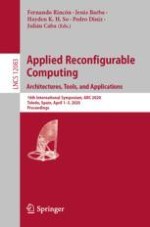2020 | Book
Applied Reconfigurable Computing. Architectures, Tools, and Applications
16th International Symposium, ARC 2020, Toledo, Spain, April 1–3, 2020, Proceedings
Editors: Fernando Rincón, Prof. Dr. Jesús Barba, Hayden K. H. So, Prof. Pedro Diniz, Julián Caba
Publisher: Springer International Publishing
Book Series : Lecture Notes in Computer Science
